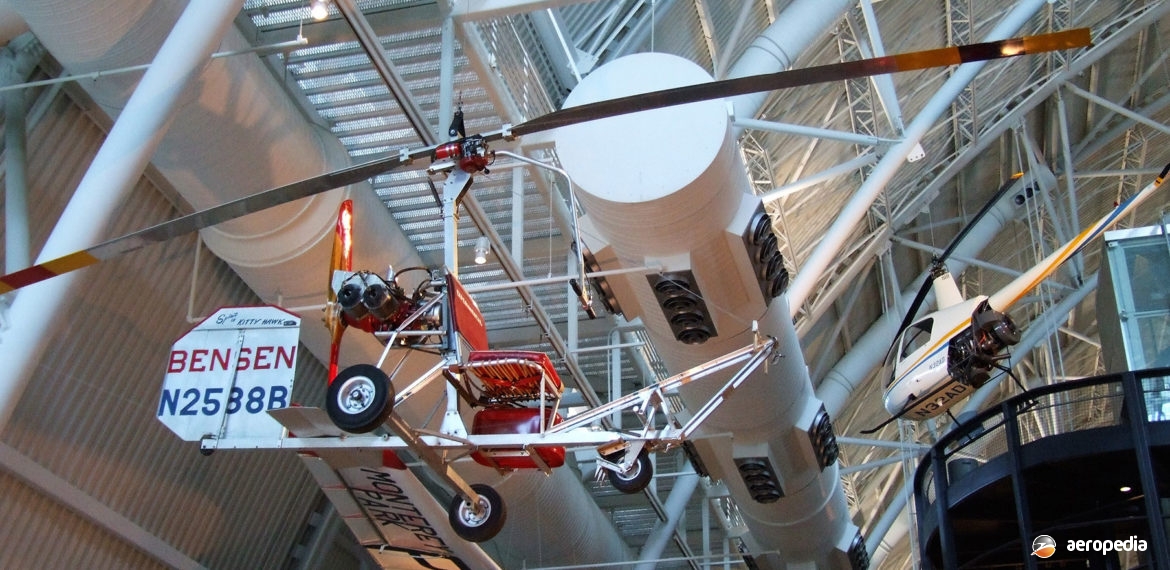Photograph:
Bensen Autogiro N2588B at the Udvar Hazy complex in Washington in July 2007 (David C Eyre)
Country of origin:
United States of America
Description:
Single and two-seat gyrocopters
Power Plant:
One 54 kw (72 hp) [1600 cc] McCulloch 4318E four-cylinder horizontally-opposed air-cooled converted drone target-plane engine
Specifications:
- Rotor span: 6.7 m (22 ft)
- Length: 3.44 m (11 ft 3 in)
- Height: 2.07 m (6 ft 9 in)
- Max speed at sea level: 137 km/h (85 mph)
- Cruising speed: 97 km/h (60 mph)
- Economical cruising speed: 72 km/h (45 mph)
- Service ceiling: 5,029 m (16,500 ft)
- Max rate of climb: 610 m/min (2,000 ft/min)
- Range: 161 km (100 miles)
- Ferry range: 483 km (300 miles)
- Empty weight: 113 kg (250 lb)
- Max payload: 136 kg (300 lb)
- Loaded weight: 249 kg (550 lb)
History:
The fore-runner of the popular gyrocopter, the Bensen series of machines was designed and developed in the mid-1950s by Dr Igor Bensen, who had emigrated from Russia to the United States after World War II. The series was designed for recreational use.
One of his first designs was the Gyroglider, introduced in 1955. Its simplicity of design and ease of flight captured the imagination of many people, leading to a number of designers using this type of design to fly, with many copying and modifying his designs to suit their own requirements.
The first in the Bensen series was the B-6, first developed in 1953, which had the free spinning rotor blades mounted above the pilot. As the machine was towed into the air by a motor vehicle or boat, speed developed and at a forward speed of 37 km/h (23 mph) the machine left the ground and the pilot steered the glider (it was not self-powered) via handlebars, the tow-rope being released and the machine being flown in free and controlled flight for up to 15 minutes.
Dr Bensen then decided to develop the design and this lead to the B-7, which was an un-powered machine also towed along an airstrip by a motor vehicle. It became the B-7M when an engine was installed in the pusher configuration behind the pilot. In 1957 the B-7M was up-graded to include a 54 kw (72 hp) McCulloch 4318 engine, this being a drone-target aircraft engine which was modified for man-carrying flight. This aircraft had an empty weight of 84 kg (185 lb), a loaded weight of 204 kg (450 lb) and a max speed of 137 km/h (85 mph).
From this was developed the B-8M, the prototype of which first flew on 8 July 1957. The first production machine flew on 9 October 1957, this being designed for the amateur constructor. Plans and kits were made available. In later years examples were fitted with the 75 hp (100 hp) Rolls Royce Continental O-200B engine, and others were fitted with the 67 kw (90 hp) McCulloch 4318G or 47 kw (64 hp) Volkswagen conversion [1600 cc].
In the United Kingdom Wing Cdr Kenneth H Wallis produced a series of gyrocopters known as the Wallis WA-116 with the 54 kw (72 hp) McCulloch engine, and later the WA-117 with the Continental O-200B four-cylinder unit. One was demonstrated in Australia. One of his machines was used in an early “James Bond” movie. Further variants included the B-8V, which was the B-8M with a Volkswagen engine; Super Bug, which was a twin-engine model, the second engine being used to spin up the rotor prior to take-off; and the B-8H Hovering Gyro Copter.
Probably more than 200 Bensen type gyrocopters have been operated in this region, produced from many designs by different concerns but all basically along the lines of the original B-7 series. At one time a small production line was set-up in premises at West Ryde, NSW, and in the 1960s Rotor-Lift Aircraft of Unley, SA, also commenced production of a number of Bensen B-7s.
In 1966 an example was fitted with twin-floats and test flown on 19 March that year at Snowdens Beach, Adelaide, SA. Other examples became known as the Aquagyro and the Gyroglider.
Many examples of the series, powered by a variety of engines, have been built and flown in this part of the world over the last 50 years. One series produced in South Australia was known as the Wasp Gyroplane, an example of this model being placed on display at the Darwin Aviation Museum in the Northern Territory in 2003 after retirement.
In New Zealand gyrocopters were registered in the G-block initially but changed to the H-block in 1955. Eventually all gyrocopters were registered in the R-block.
More than 20 examples of the Bensen series of designs were registered, including ZK-GBL, ZK-HAM, ZK-HBO, ZK-HBU, ZK- HVV, ZK-HBX, ZK-HCJ, ZK-HCT, ZK-HCY, ZK-HCZ. R-block registered aircraft were ZK-RAB (c/n PRA/4846/A – ex ZK-HCY); ZK-RAC (PRA83/2 – ex ZK-HBV); ZK-RAG (PRA/52253/2 – ex ZK-HCZ); ZK-RAH (c/n PRA/134/01); ZK-RAJ (c/n NZRA/181/1); ZK-RAL (c/n PRA/5253); ZK-RAM (c/n PRA/8025/1); ZK-RAO (c/n 251685); ZK-RAP (c/n NZRA/R28); ZK-RAT¹ (c/n NZRA/R11); ZK-RAT² (c/n R83); ZK-RBB (c/n NZRA/R36); ZK -RBC (c/n NZRA/R54); ZK-RBH (c/n NZRA/R76); ZK-RBJ (c/n NZRA/R62); ZK-RBX (c/n NZRA/R41); ZK-RCI (c/n NZRA/R30); ZK-RCN (c/n (NARA/R30); ZK-RDC (c/n GLW1); ZK-RDD (c/n GLW2) and ZK-RAY² (c/n PFA-G/01A-111).
Most Australian examples were not registered and were imported or built before new regulations relating to gyrocopters were introduced. The only example I have been able to find has been a B-8M which became G-0414.

